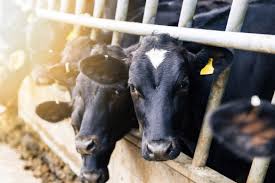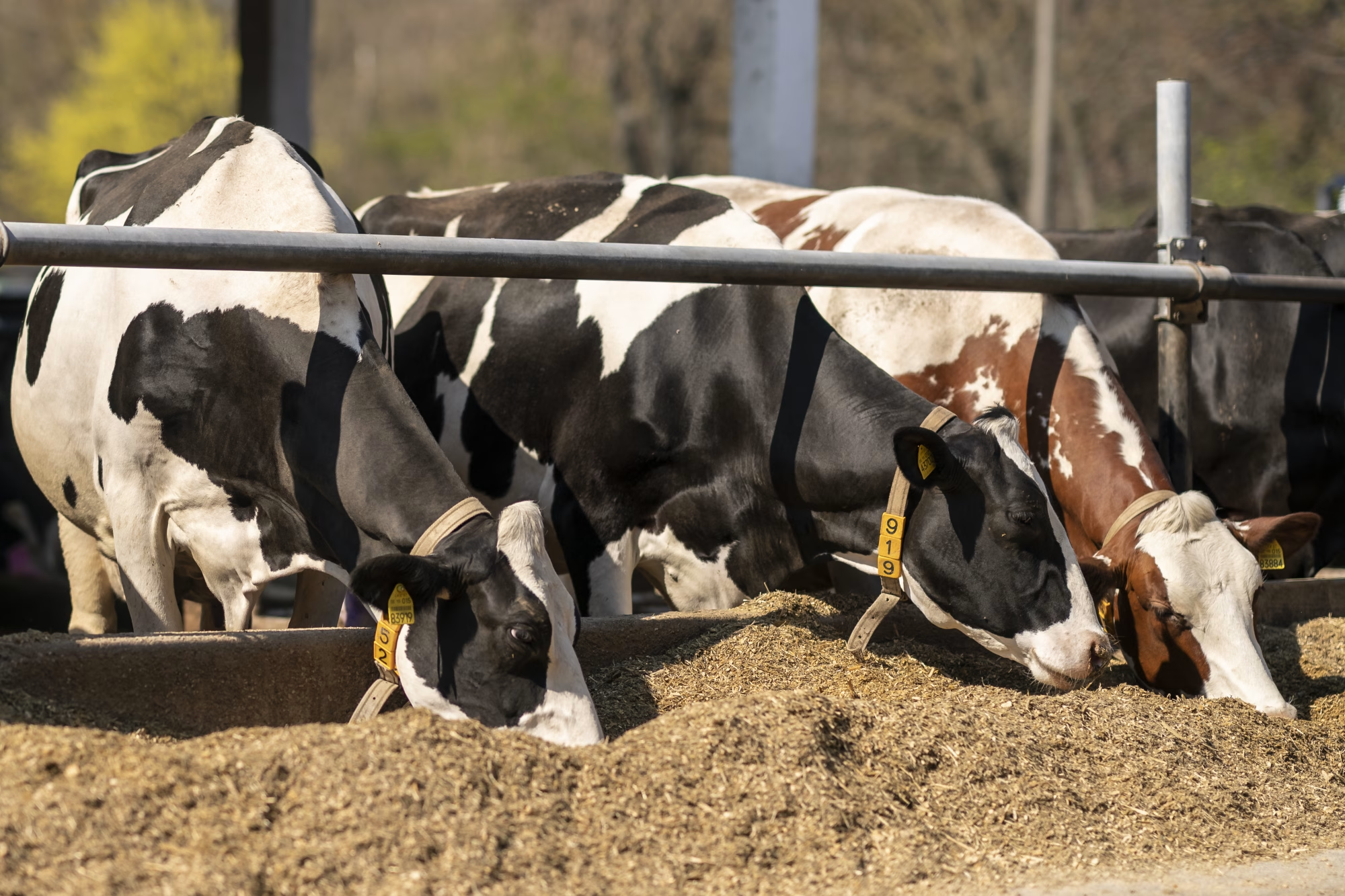Can synthetic pheromones revolutionize cattle health and productivity? Dive into the latest study insights to see if this is the game-changer your herd needs.
Summary:
The Texas A&M University study, recently published in the Journal of Animal Science, underscores the benefits of Maternal Bovine Appeasing Substance (MBAS) for high-risk cattle during a 60-day feedlot receiving period. Marketed as FerAppease since 2022 and administered in over 15 million doses, MBAS has shown significant results in reducing physiological stress markers, lowering cortisol levels in hair samples, and improving immunological responses, including greater blood concentrations of antibodies against the parainfluenza-3 virus (PI3). The study, which involved 120 Angus-influenced, recently weaned male calves, found that MBAS-treated calves exhibited reduced mortality rates and better health outcomes, resulting in a pen-based productivity gain of 498 kg compared to the control group and yielding a remarkable 1,541% return on investment. This compelling evidence suggests that dairy farmers should consider MBAS a vital tool for enhancing cattle health and productivity.
Key Takeaways:
- A Texas A&M University study confirms that administering MBAS (FerAppease) significantly decreases physiological stress markers in high-risk cattle.
- MBAS-treated cattle showed an 83% reduction in mortality during the 60-day feedlot receiving period.
- While MBAS did not alter average daily gain (ADG) or feed intake, it improved overall pen-based productivity.
- MBAS increased the efficacy of antimicrobial treatments, with 70.6% of BRD-affected calves needing only one treatment to regain health.
- Serum cortisol levels post-castration were lower in MBAS-treated calves, indicating reduced stress.
- MBAS administration increased antibody concentrations against PI3 virus, suggesting enhanced vaccine efficacy.
- The nasal microbiota of MBAS-treated cattle had a lower prevalence of Mycoplasma, reducing BRD-related pathogens.
- Economic analysis shows a significant return on investment (ROI) of 1,541% for MBAS-treated pens due to lower mortality and higher productivity.

Imagine a solution that empowers calves to combat stress and enhance their overall health without the need for additional medication. This is the promise of synthetic pheromones, a revolutionary tool in the dairy industry. These artificially created compounds mimic the effects of natural pheromones, the secret language of animals, and offer a range of benefits for cattle management.
In a pioneering study published in the Journal of Dary Science, Texas A&M University, researchers investigated the effects of a synthetic pheromone known as Maternal Bovine Appeasing Substance (MBAS). This chemical, known commercially as FerAppease, is intended to mimic the soothing pheromones released via the skin of breastfeeding cows. The analysis revealed an impressive 1,541% ROI.
So, why is this research so groundbreaking? Let’s explore how synthetic pheromones could potentially revolutionize your cattle management strategies, boost production, and elevate your herd’s health to new heights.
Confronting Stress: The Unseen Challenge in Dairy Farming
Dairy farming is a complex sector that presents various hurdles. One of the most critical problems is cow stress and health difficulties, particularly during considerable transitions, such as weaning, transportation, and feedlot receipt. Stress may cause immunosuppression and an increased susceptibility to illnesses such as bovine respiratory disease (BRD). For dairy producers, addressing these stresses is critical to the health and production of their herd.
The Maternal Bovine Appeasing Substance (MBAS) is a new approach that is gaining popularity in the market. MBAS is a synthetic counterpart of a natural pheromone released by nursing cows’ mammary glands. This pheromone enhances calf-cow bonding by identifying mother scents and significantly relieves stress, improving general well-being.
Game-Changing Insights from Texas A&M’s Pioneering StudyThe Texas A&M University research, just published, provides vital insights into the advantages of providing maternal bovine appeasing substance (MBAS) to high-risk animals. The investigation was conducted on 120 Angus-influenced, recently weaned male calves using a tightly controlled approach. The calves, obtained from an auction facility and weighed roughly 199 kg upon arrival, were separated into two groups. One group got MBAS, while the other acted as a control and received mineral oil. The therapies were administered topically to specified parts of the calves’ skin on days 0 and 14, in addition to routine vaccination, deworming, and other feedlot procedures.
The primary goal was to evaluate the health, physiological, and performance responses throughout the 60-day feedlot receiving period. The necessary procedures included monitoring feed intake and bovine respiratory disease (BRD) incidence daily and collecting blood and hair samples at regular intervals for physiological examination. Nasal swabs were also collected for microbial study. The significant results showed that calves given MBAS had much lower physiological stress signals, as shown by decreased cortisol levels in hair samples. Furthermore, these calves had better health outcomes: a significant proportion needed just one antibiotic treatment for BRD, and overall mortality was much lower. This resulted in increased pen-based production and a considerable increase in live weight after the research.
Why MBAS Should Be on Every Dairy Farmer’s Radar
Using Maternal Bovine Appeasing Substance (MBAS) for high-risk calves offers significant advantages that dairy farmers should not overlook. Let’s break down these benefits using the Texas A&M University research findings.
- Reduced Mortality
One of the study’s most notable results is the significant reduction in calf mortality due to MBAS treatment. According to the study, calves given MBAS had a mortality rate of just 1.66%, compared to 10.0% in the control group (P=0.04). This reduction corresponds to an 83% decrease in mortality, providing a reassuring outcome for dairy farmers. - Improved Immune Response
MBAS not only saves calves’ lives but also helps them flourish. The research found that calves treated with MBAs had improved immunological responses. Calves had substantially greater blood concentrations of antibodies against the parainfluenza-3 virus (PI3) on days 42 and 60 (P ≤ 0.03). Improved immune response implies fewer illnesses and more excellent general health, which reduces veterinary expenditures and the need for antibiotics. “The increased serum antibody levels in MBAS-treated calves highlight the substance’s role in strengthening the immune system,” says Dr. Colombo, one of the leading researchers. - Increased Productivity
When we talk about productivity, the data speak for themselves. MBAS-treated calves gained 498 kg/pen compared to 309 kg/pen in the control group (P=0.04), yielding a 1,541% return on investment (ROI). The economic advantages are apparent, particularly given the reduced need for medical treatments. “The ROI figures highlight how MBAS doesn’t just benefit the animals’ health but also adds significant value to farming operations,” says Dr. Cappellozza, another study researcher.
MBAS uses a multifaceted strategy to improve the health and production of high-risk calves. The considerable decrease in mortality, enhanced immunological responses, and greater output are supported by complicated statistics and expert testimony, making MBAS an essential component of contemporary dairy farming.
The Economic Case for MBAS: Boosting Productivity and Profitability
Understanding the economic implications of using MBAS is critical, particularly for dairy producers trying to increase their profits. The current Texas A&M research found convincing advantages, including higher live weight output in cattle treated with MBAS. Calves treated with MBAs had considerably higher total pen-based live weight, increasing overall output.
Furthermore, the research found a significant return on investment (ROI) of 1,541% for pens treated with MBAS. This dramatic ROI results from better calf health, lower death rates, and improved responsiveness to antimicrobial treatments, which lowered expenses and raised ultimate live weight value. The lowered mortality and improved efficiency of antimicrobial treatments directly led to increased profitability, demonstrating MBAS’s potential financial benefit.
Dairy producers who implement MBAS should expect to improve the health and welfare of their animals and have a beneficial ripple impact on their income. The economic advantages of reduced mortality and improved live weight output translate into better profit margins, making MBAS an intelligent investment for maintaining and developing a dairy farming operation.
Reduced Stress and Enhanced Immunity: The Dual Benefits of MBAS Treatment in High-Risk Cattle
High-risk animals treated with MBAS had considerable physiological and immunological benefits. One of the most significant results was a drop in stress indicators, notably cortisol levels, a reliable measure of animal stress. The research discovered that blood cortisol levels were lower in MBAS-treated calves after castration, indicating that MBAS aids in reducing physiological stress responses generated by painful operations.
Additionally, the long-term stress signal, cortisol in hair, was lowered. This suggests that MBAS benefits not only in acute stress circumstances but also in reducing chronic stress over time. On days 14 and 28, hair cortisol concentrations were significantly lower in MBAS-treated calves, corresponding to the time when MBAS is most effective.
In addition to stress reduction, MBAS-treated cattle showed improved immune responses. On days 42 and 60 after therapy, the research found greater blood levels of antibodies against the parainfluenza-3 virus (PI3). This enhanced antibody response shows that MBAS boosts the immune system, making cattle more resistant to illnesses and boosting the effectiveness of immunizations delivered during the early processing stage.
The Hidden Power in a Calf’s Nose: How MBAS Impacts Nasal Microbiota
One of the most surprising discoveries from the Texas A&M research is the nasal microbiome of cattle. Researchers found that injecting the synthetic pheromone MBAS significantly reduced the incidence of Mycoplasma, a key pathogen linked with bovine respiratory disease (BRD) [Czuprynski et al., 2004; Caswell and Archambault, 2007]. Specifically, the prevalence of Tenericutes, including Mycoplasma, was significantly lower in calves treated with MBAS compared to those given a placebo.
Why does this matter? The nasal microbiome is essential for sustaining respiratory health. Stress-induced immunosuppression may disrupt the delicate balance of this ecosystem, increasing harmful microorganisms such as Mycoplasma. This overgrowth may worsen BRD, a primary cause of morbidity and death in feedlot cattle. MBAS encourages a more balanced nasal microbiome by lowering Mycoplasma prevalence, improving cattle’s natural defensive mechanisms against respiratory illnesses.
Although the frequency and timing of BRD indications were comparable across the treatment and control groups, the MBAS group had a lower prevalence of Mycoplasma, which corresponded with better outcomes. Notably, calves treated with MBAS responded better to the initial therapeutic antimicrobial therapy and had decreased fatality rates. This shows that MBAS reduces stress and improves the effectiveness of following medical treatments, allowing for a more complete approach to improving cow health.
These microbiome findings are remarkable and need more exploration. They substantially support MBAS’ immune-boosting advantages, especially in high-stress situations like feedlot feeding. The results suggest a viable approach to decreasing antibiotic use while boosting cow health and production.
The Bottom Line
This research from Texas A&M University highlights the strong influence of the maternal bovine appeasing substance (MBAS) on high-risk calves during the key feedlot receiving phase. MBAS has proved to be an effective strategy for improving overall herd health by lowering physiological stress signs, increasing immunity, and, as a result, decreasing death rates. Notably, the research found a stunning 1,541% ROI, indicating a solid economic rationale for its use in dairy businesses. The proof is clear: MBAS therapy may improve your cattle’s health and operation’s profitability and efficiency. If you want to improve the resilience and production of your herd, MBAS might be a game changer.
Learn more:
- Leveraging Herd Genotyping & Sexed Semen: A Game-Changer in Livestock Industry
- Boost Your Dairy Profits: Proven Breeding Strategies Every Farmer Must Know
- Unlock the Secret to Doubling Your Dairy Herd’s Rate of Genetic Gain: The Power of Cloning Revealed!
 Join the Revolution!
Join the Revolution!
Bullvine Daily is your essential e-zine for staying ahead in the dairy industry. With over 30,000 subscribers, we bring you the week’s top news, helping you manage tasks efficiently. Stay informed about milk production, tech adoption, and more, so you can concentrate on your dairy operations.







 Join the Revolution!
Join the Revolution!






